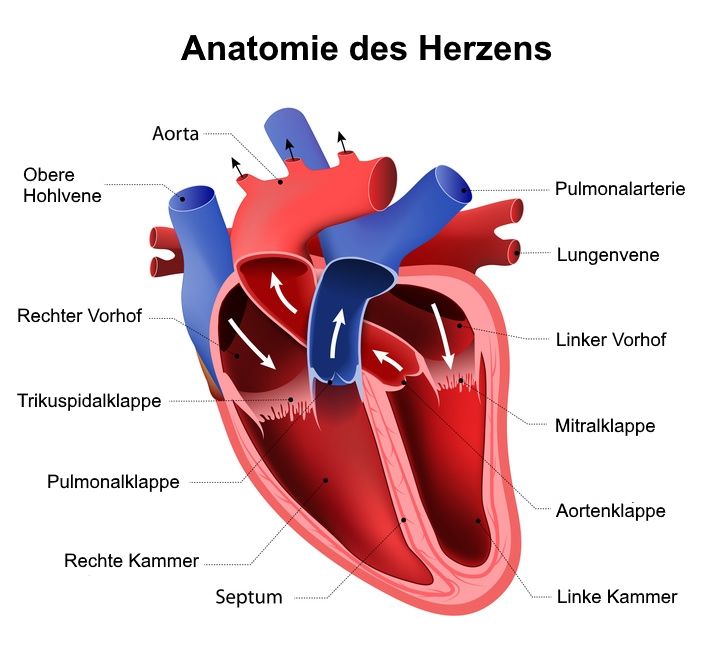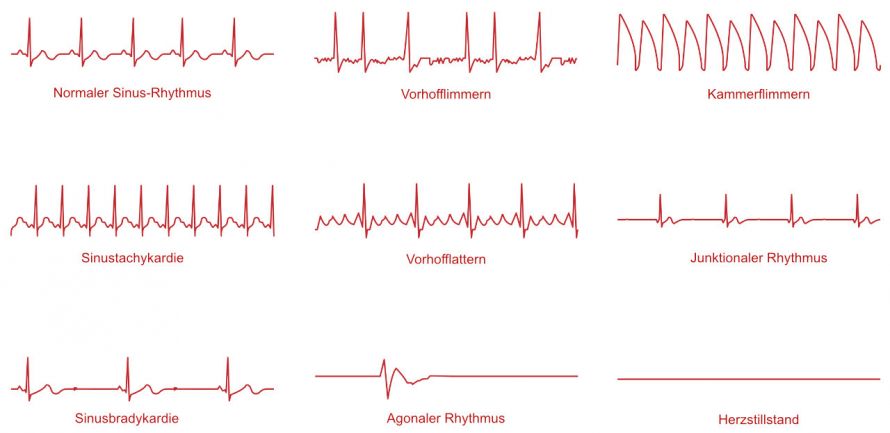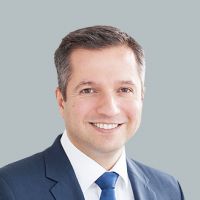Cardiac arrhythmias are abnormally altered heartbeat sequences. This is a disturbance in the formation or spread of excitation in the heart. Cardiac arrhythmias are also known as arrhythmias.
In the case of cardiac arrhythmia, the heartbeat can be faster than normal
- too slow (below 60 beats per minute, bradycardia),
- too fast (over 100 beats per minute, tachycardia), or
- irregularly, i.e. with extra beats.
Disorders of excitation formation are also summarised under the name sick sinus syndrome or sick sinus node syndrome.
Cardiac arrhythmias can originate from different areas of the heart:
- Atrium,
- Ventricle,
- AV node,
- Sinus node or
- Excitation conduction system.

Cardiac arrhythmias can originate in different parts of the heart © designua | AdobeStock
The occurring disturbances are then named after the place of their occurrence, for example
- atrial flutter and atrial fibrillation,
- Ventricular flutter and fibrillation or
- AV blockages and disorders in the sinus node.
Some forms of cardiac arrhythmia can be dangerous, such as
- ventricular fibrillation and
- ventricular tachycardia.
Other forms, however, are relatively harmless.
If the conduction of excitation within the heart is blocked, we can speak of the following conditions:
- Sinuatrial block: The conduction between the sinus node and the atrium is disturbed.
- Atrioventricular block (AV block): The conduction between the atrium and the ventricles is disturbed.
Right bundle branch block or left bundle branch block: The conduction to the right or left branch of the ventricular conduction system (tawara branch) is disturbed.
The distinction between the individual rhythm disorders, such as terms like flutter and fibrillation, can be somewhat confusing. Therefore, below you will find a brief overview of some important arrhythmias.
Sinus tachycardia: Heartbeat that is too fast, originating from the sinus node. The causes can be varied, often lying outside the heart, for example in stress or Thyroid disorders.
Sinus bradycardia: A heartbeat that is too slow, originating from the sinus node. Sinus bradycardia is normal in well-trained athletes ("athlete's heart") or during sleep. However, this can also be caused by various underlying diseases, such as
Atrial flutter: The atrium is excited up to 300 times per minute. However, not all excitations are transmitted to the ventricles, so the ventricles usually beat more slowly. The symptom is described as having palpitations.
Atrial fibrillation: The atrium is excited over 300 times per minute. The ventricles then beat up to 180 times per minute (in children up to 200 times), which is experienced as uncomfortable.
Atrial fibrillation is one of the most common cardiac arrhythmias in Germany. Although it relatively rarely leads to a medical emergency, it is associated with an increased risk of, among other things
Ectopic atrial tachycardia: In addition to the sinus node, there are other excitation centres in the atrium that trigger excitation. This causes the heart to race.
AV node re-entry tachycardia (AVNRT): In the AV node, instead of only one conduction pathway, there are two pathways that can "short-circuit". This is also perceived as heart palpitations. AVNRT is the most common congenital heart disease and affects mainly the female sex.
Wolff-Parkinson-White syndrome (WPW syndrome): Due to an additional bundle of conductors between the atrium and the ventricles, there is a circular excitation. It manifests itself as palpitations.
Ventricular tachycardia (VT): The cause of the increased heart rate lies in the heart chambers. This is a life-threatening cardiac arrhythmia.
Ventricular flutter and fibrillation: The heart beats so fast that the blood can no longer be pumped sufficiently into the body. This is a medical emergency! In ventricular flutter, the heart beats 200 to 350 times per minute, in ventricular fibrillation over 320 times. The transition between the two forms is fluid.
Cardiac arrhythmias can be caused by
- congenital diseases,
- acquired diseases or
- external influences
. Congenital diseases that can trigger cardiac arrhythmias include the following
Acquired diseases such as
can also be responsible for an arrhythmia.
External causes are for example
- Excessive alcohol and caffeine consumption,
- Drug side effects,
- Nervousness and
- Infections.
Some patients have no symptoms. Others, on the other hand, perceive the altered heartbeat sequence as
- Cardiac stuttering,
- Heart palpitations,
- Palpitations or
- Pauses in the heartbeat.
Possible symptoms of a slow heartbeat are:
Possible symptoms of a fast heartbeat are
In the worst case, an arrhythmia can also lead to
The diagnosis is made on the basis of a physical examination. Here the doctor feels the pulse and listens to the heart.
In addition, an electrocardiogram (ECG) is carried out. By recording the electrical currents of the heart in the ECG, an arrhythmia and its type can often be recognised immediately.
In the case of rare or irregular arrhythmias, a long-term ECG device is used. It records the heart rhythm over 24 or more hours. An event recorder can be used as an alternative or supplement to the long-term ECG. The patient starts it when they perceive a disturbance in the heartbeat.
If necessary, further examinations are carried out to find the cause of the arrhythmia.

An electrocardiogram can be used to distinguish between the different forms of cardiac arrhythmia © mattbadal | AdobeStock
The treatment depends on the type and cause of the disorder as well as the severity of the symptoms. If the cause is organic, this must also be treated.
Drugs used to treat cardiac arrhythmias are known as antiarrhythmics. These drugs can influence the formation and transmission of electrical excitations and thus the heart rate in different ways.
A pacemaker is usually implanted when the heartbeat is too slow. Through electrical impulses, it dictates the heart rate to the heart.
A defibrillator is implanted in case of recurrent dangerous arrhythmias. It detects threatening disturbances and ends them with electrical impulses.
A cardiac catheter ablation is carried out to sclerotise the diseased areas (e.g. atrial fibrillation) in the heart. This stops the disturbed excitation conduction.
Through a heart operation (for example bypass surgery), doctors can eliminate the conditions that lead to reduced blood flow and thus indirectly to an arrhythmia.
Specialists for cardiac arrhythmias are specialists for cardiology.
Depending on the cause of the disorders, other specialists such as
may be consulted.

















